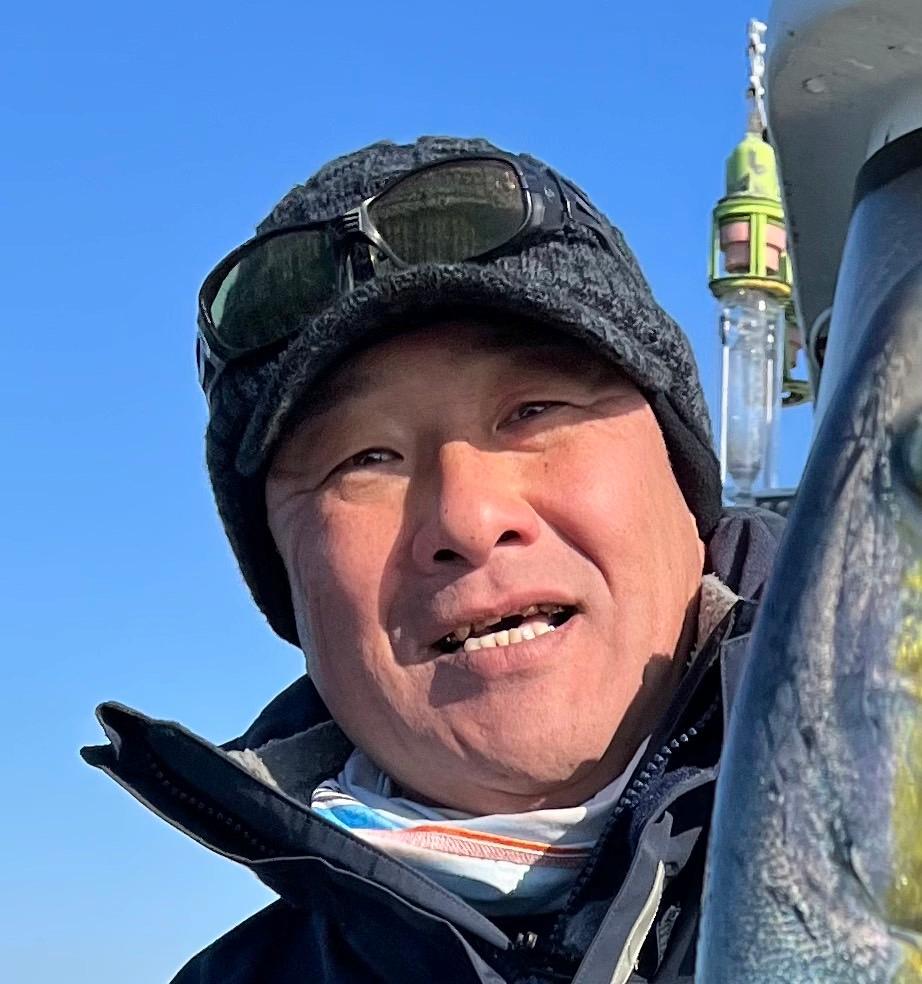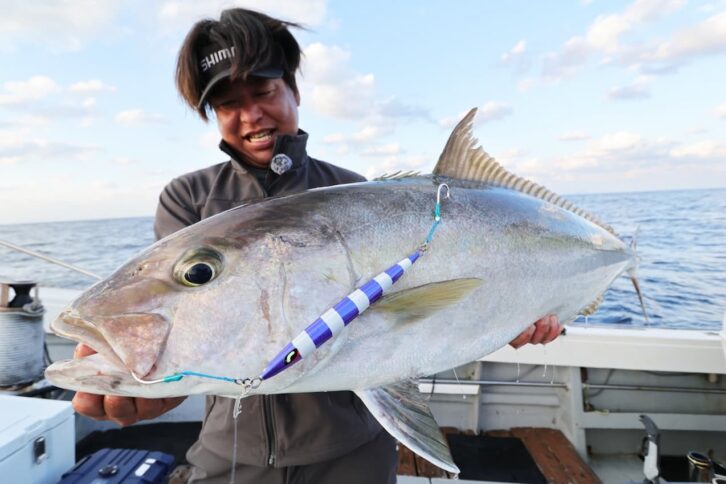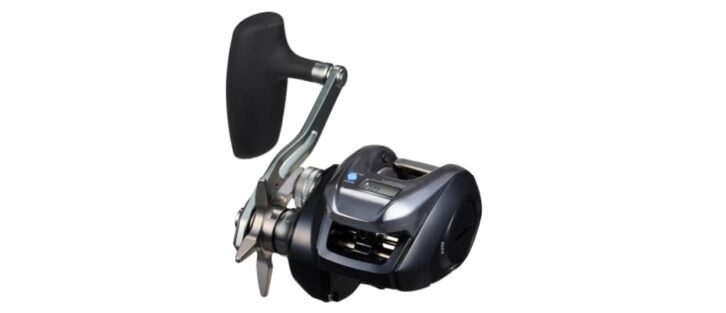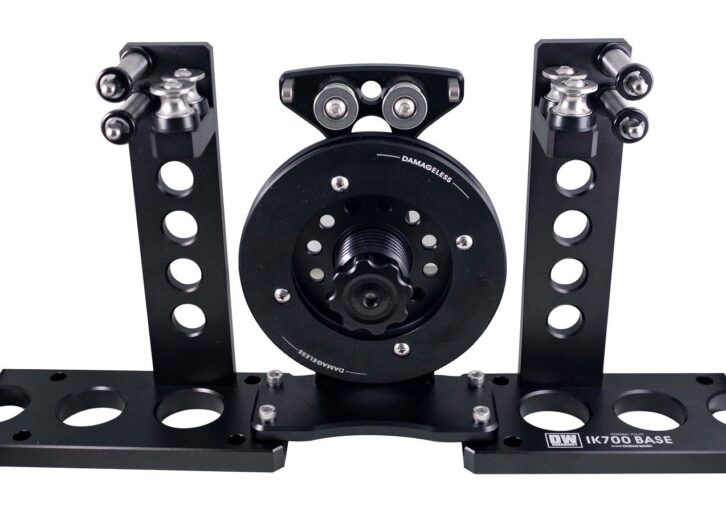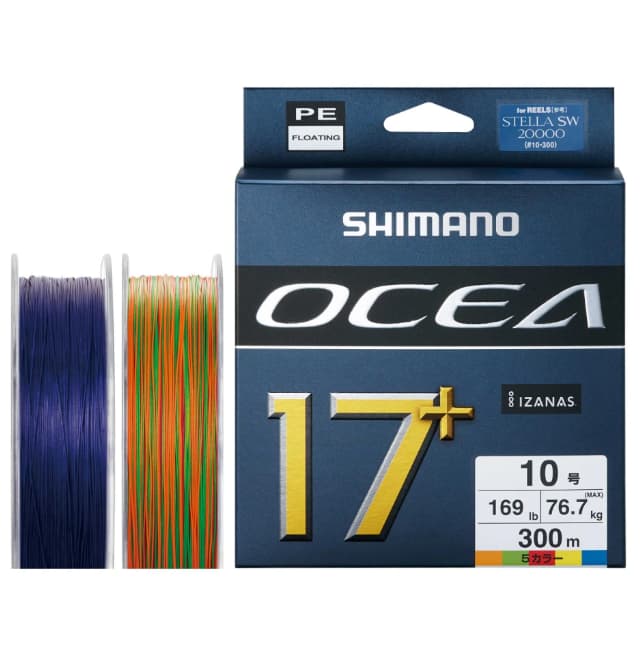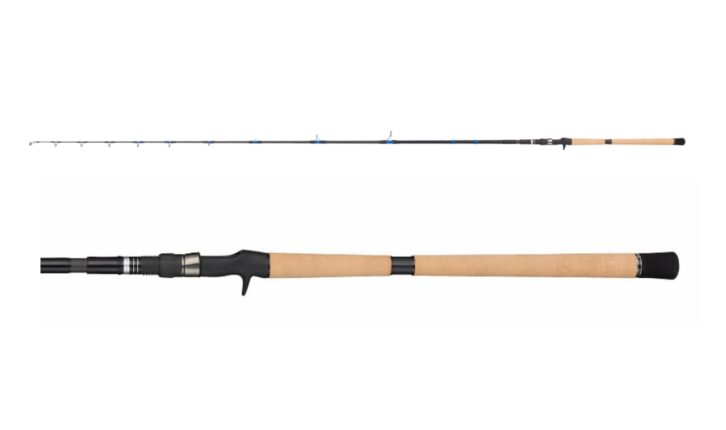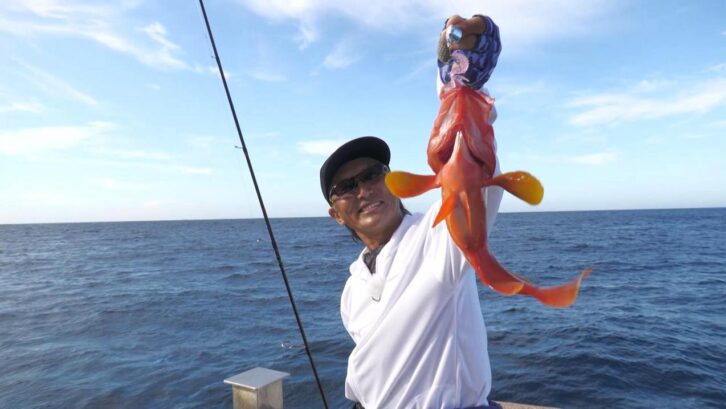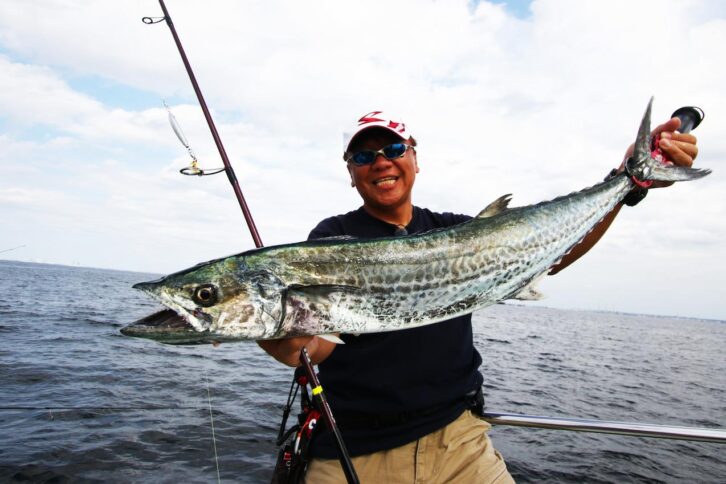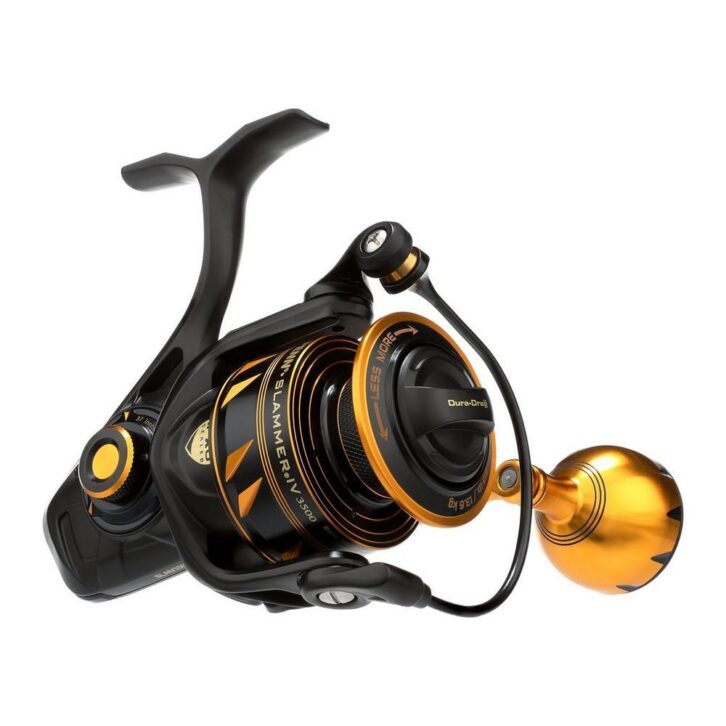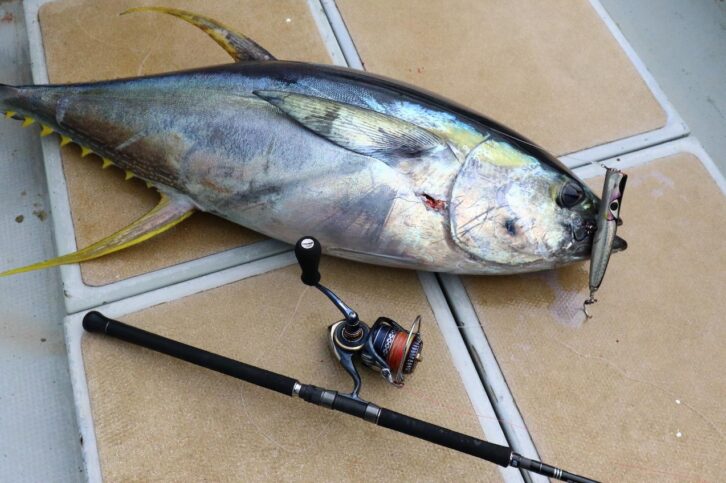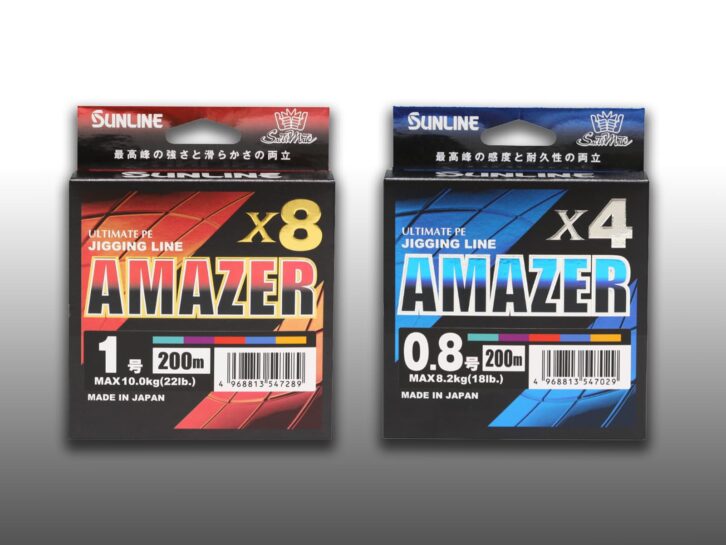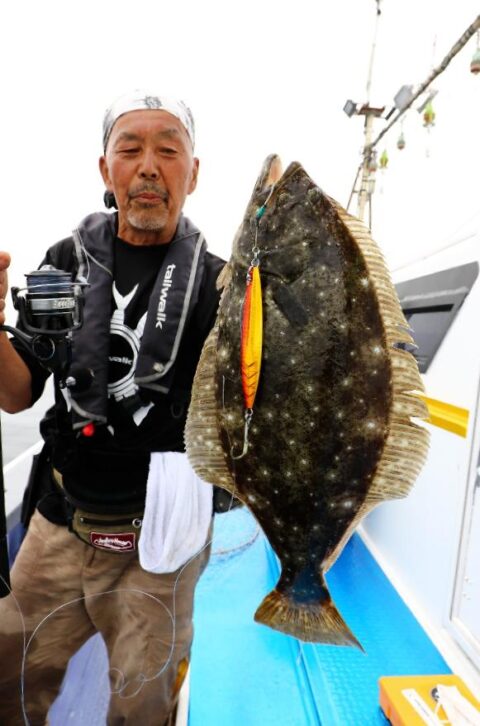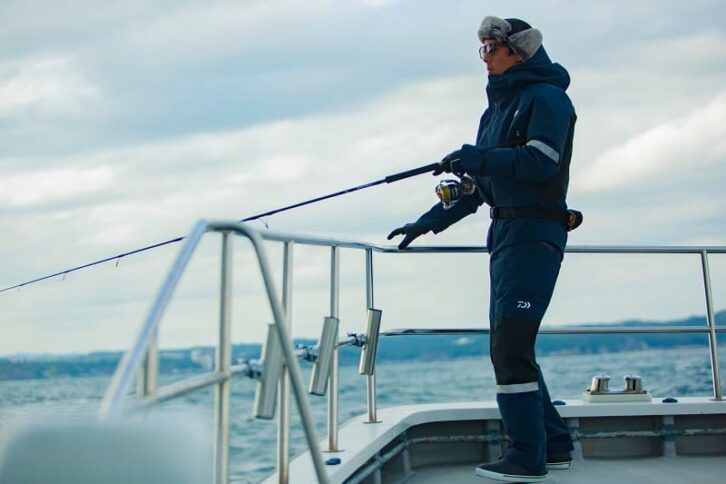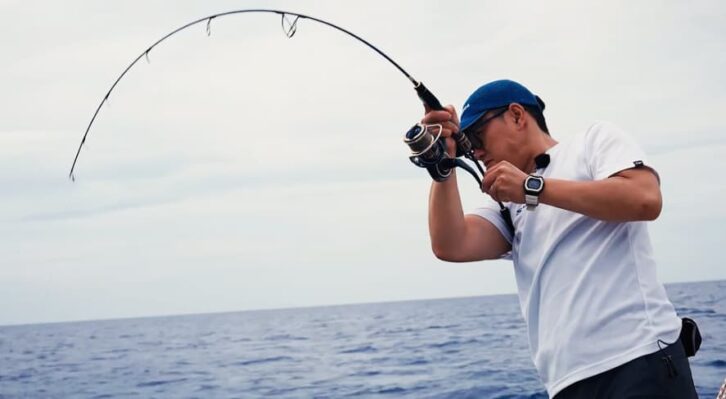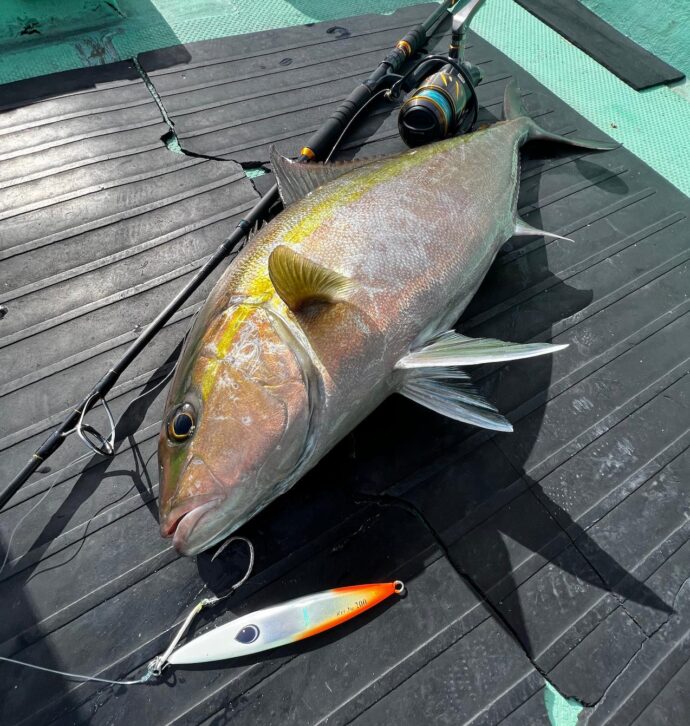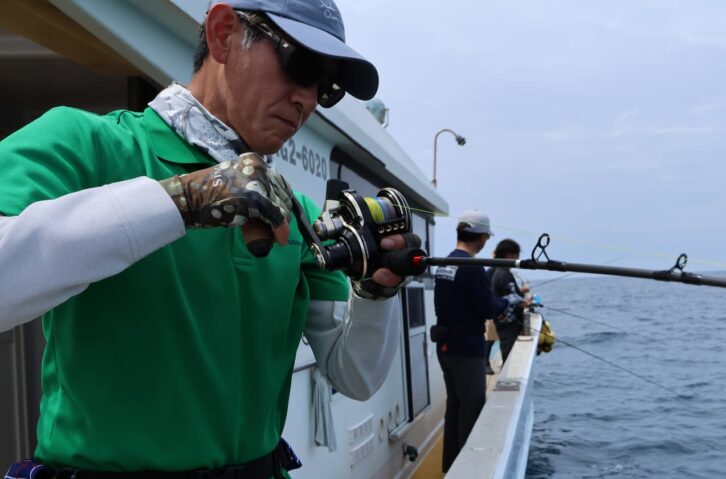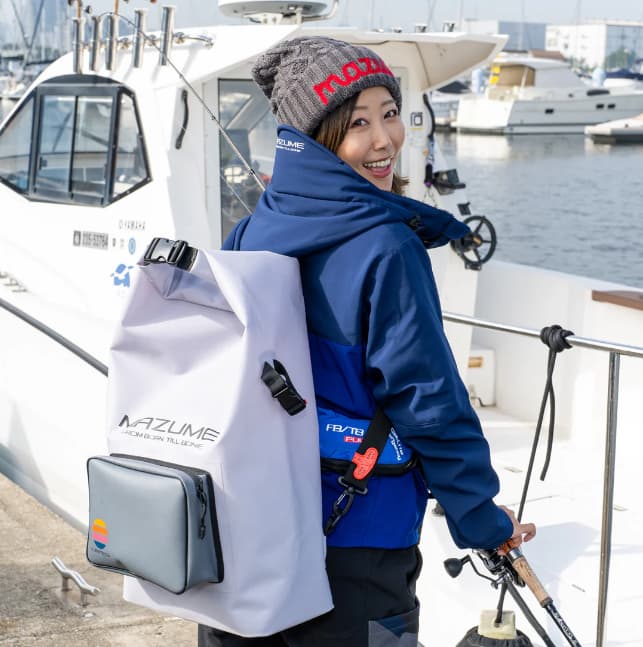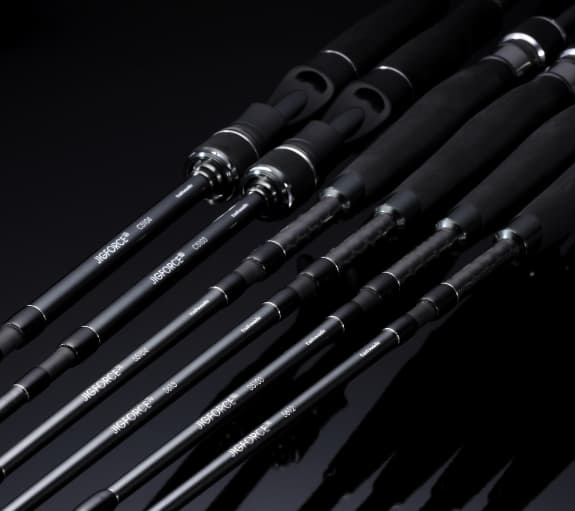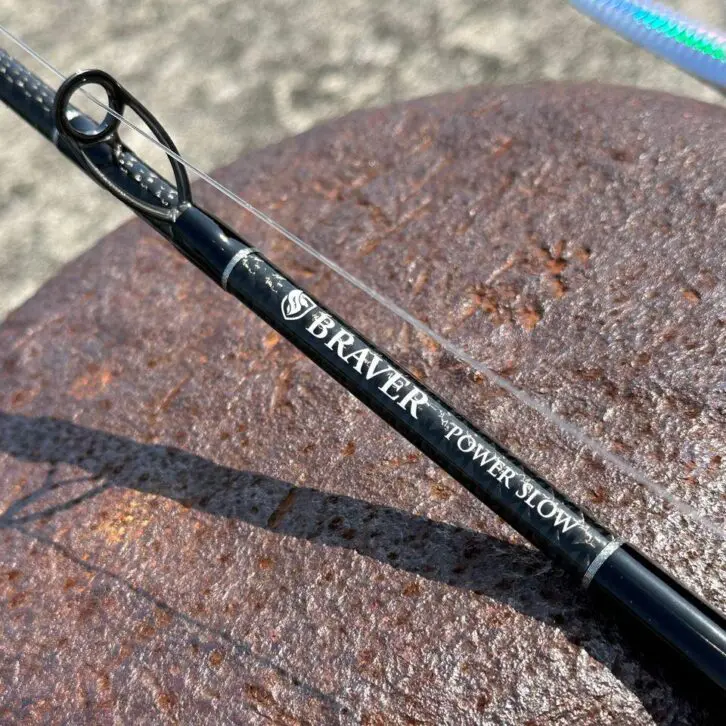Serialization: Kei Hiramatsu's Offshore World vol.25
Offshore Real Fishing Tsushima, Nagasaki in Spring Catching a 20.17kg yellowtail by jigging
Jigging for wintertime Tsushima yellowtail which was featured in the last issue of this series, had a great impact on the catches of this spring's yellowtail game. Fishing for yellowtail in the deep zone, where the fishing conditions change greatly depending on the tide. This time, we would like to report a close-up of our success in catching a 20kg-plus yellowtail by jigging.
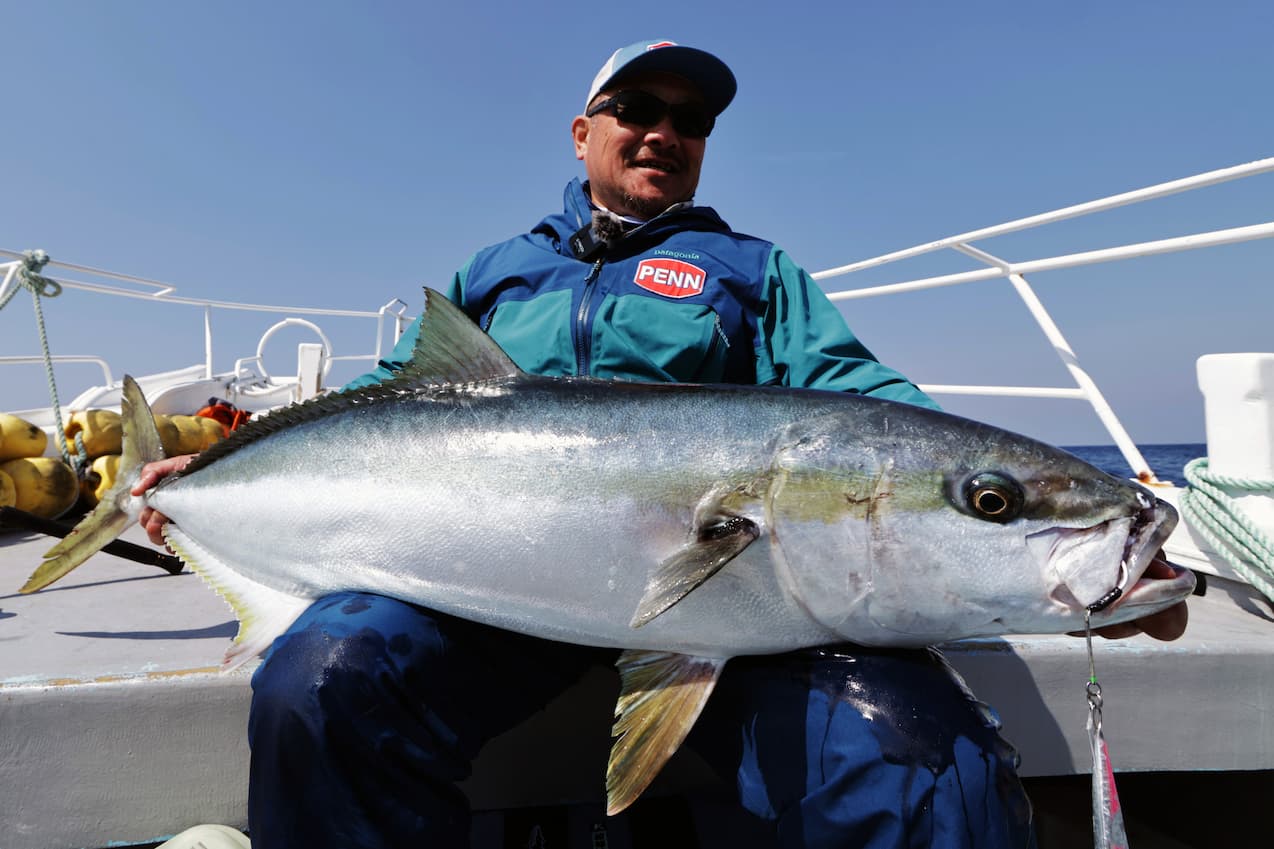
INDEX
How to jig off the west coast of Tsushima, a familiar spot for anglers.
Off the coast of Tsushima in Nagasaki Prefecture is a field that I continue to visit as a “yellowtail dojo” for me. It is a place where I have practiced with many yellowtail and gained experience. I have fished a lot to make sure that I get the best chance when the time comes. He has accumulated countermeasures, a sense of foresight, and offensive and defensive skills against the strong fish, which he never knows when the chance to hit comes, through his fishing practice and has been able to “draw out” them and connect them to many hits of yellowtail. In the previous winter trip to Tsushima, we thoroughly explored how to target yellowtail while other fish were mainly hitting.
With the cherry blossoms blooming in the spring, it was time to get into the full-fledged season for targeting yellowtail, and on the last weekend of March, we went to Tsushima again this year. This time, Captain Takuya Haruta of the Haruyo Maru had his sights set firmly on the spot. He knew that the best place to catch Tsushima yellowtail in spring was off the west coast of Tsushima. Nothing is more reassuring than a captain’s confidence.
Please catch it, Kei-san,” said Captain Takuya with his big body and kind smile. Tsushima is a long island stretching from north to south, with Zhaozaki to the south and Tsozaki to the north. Both are top-notch points and popular with anglers who know Tsushima’s offshore game. I have experienced good feelings in both areas depending on the season. Depending on the season, when the timing is right, I also make a request. And this time, Captain Takuya and I agreed. That is the offshore rapids off the west coast of Kami-Tsushima.
This is a point with deep water, but if the tide and wind direction are right, “something” will happen. Last year, an 80kg rockfish was caught here, and of course, the area is recognized as one of the best areas in Tsushima in terms of the amount of yellowtail stocked. We headed offshore with a plan to target fish reefs and rapids around the rapids here.
On this day, there was a gentle northeast wind. We went offshore before noon and started from the fish reef at the 90-meter line. The current was strong as the calendar was moving from mid-tide to high-tide. When the tide starts to move heavily, it is a difficult place to put a metal jig into the area you want to target. It is difficult to pull out good size sunfish at the time when many fish can be caught, and yellowtail and sunfish weighing less than 10 kg attack the jig vigorously. The young and energetic fish are the first ones to bite hard, and they are unable to reach the mouths of the good-sized sunfish that we really want to catch. The boatmates caught yellowtail and sunfish. First of all, we could judge that the fish were very active.
With the bite picking up, Captain Takuya headed for the main target point. After a 10-minute drive, we arrived at the main point. From here I concentrated even harder.
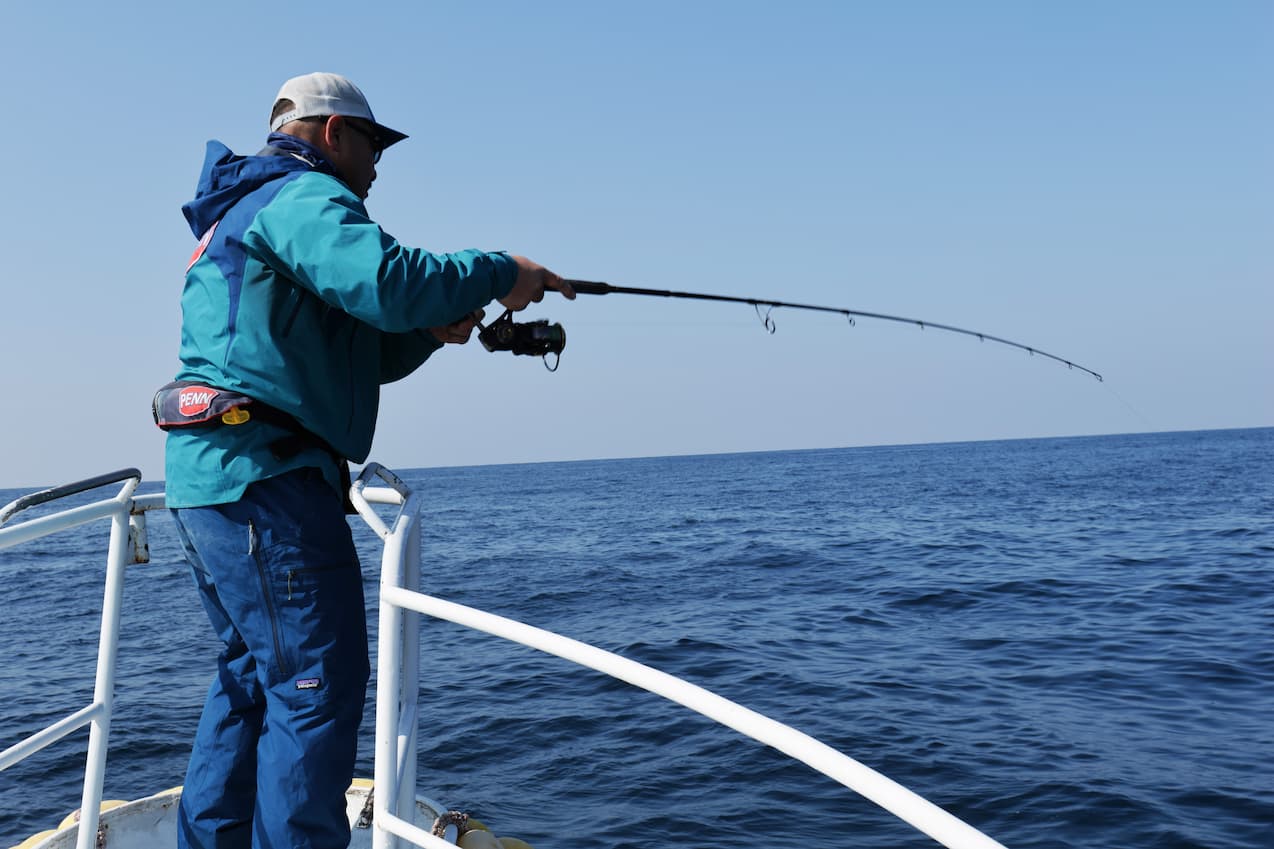
Concentrating on moving the jig at the main point. The timing for targeting large fish at this location was not long. The tide is just right for a short period of time. This is when the fish are more active and before the tide goes out.
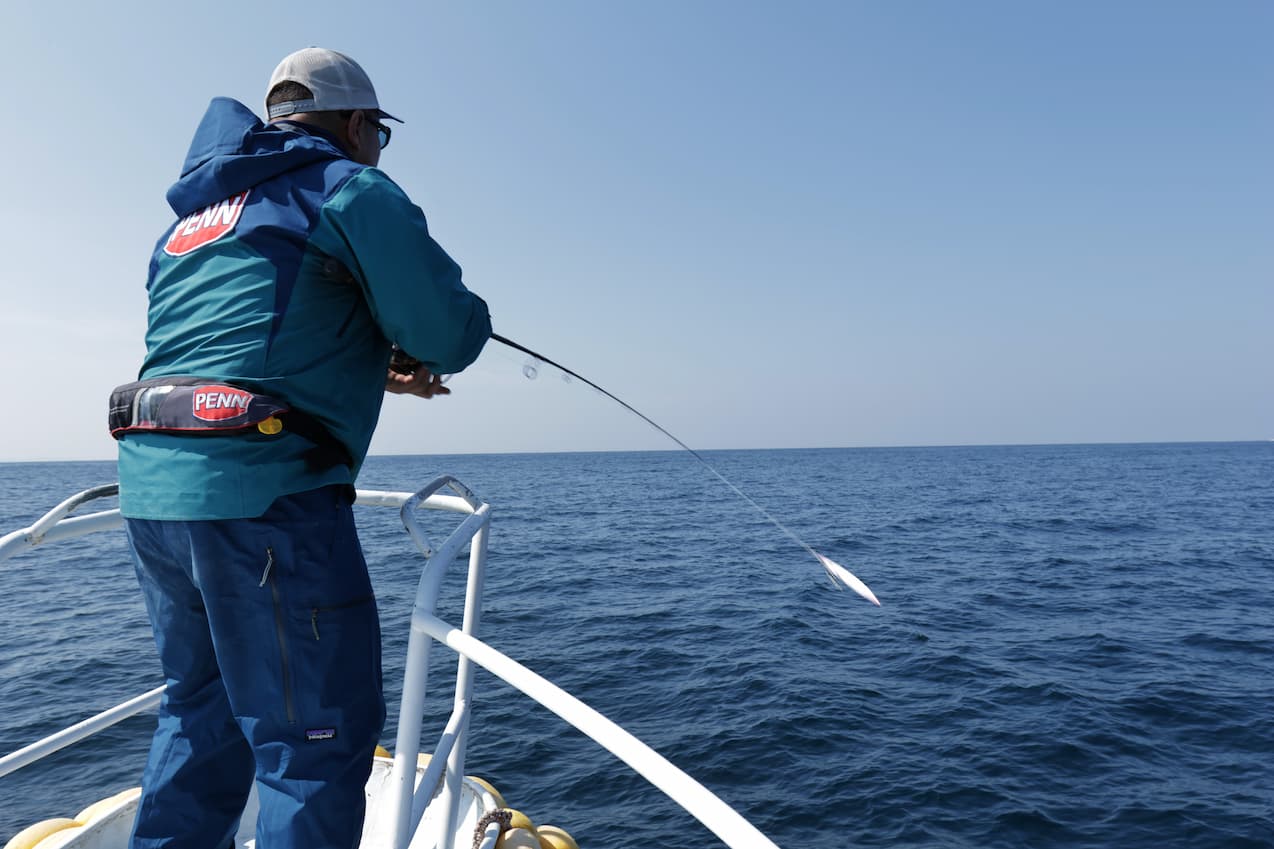
After checking the speed of the tide, we cast the jig on the tide. After landing the jig on the bottom, first take up the line slack, and then adjust the angle so that the jig is at the best angle when it is placed on the bottom again.
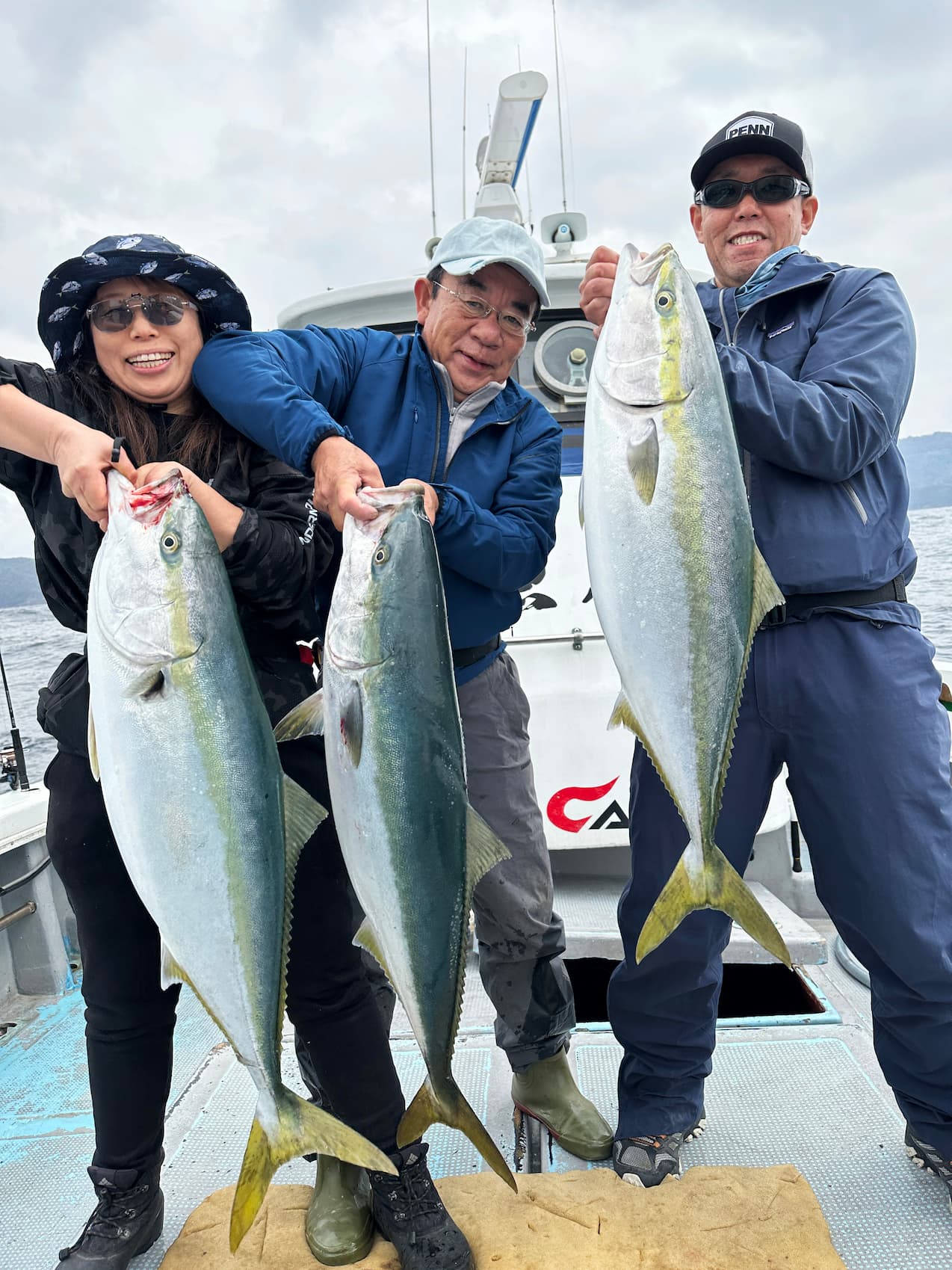
Yellowtails were striking at the reefs off the west coast of Kami-Tsushima and at the Seto. The maximum weight is about 10 kg. Round and fat individuals. However, to catch good-sized sunfish, you must avoid these fish.
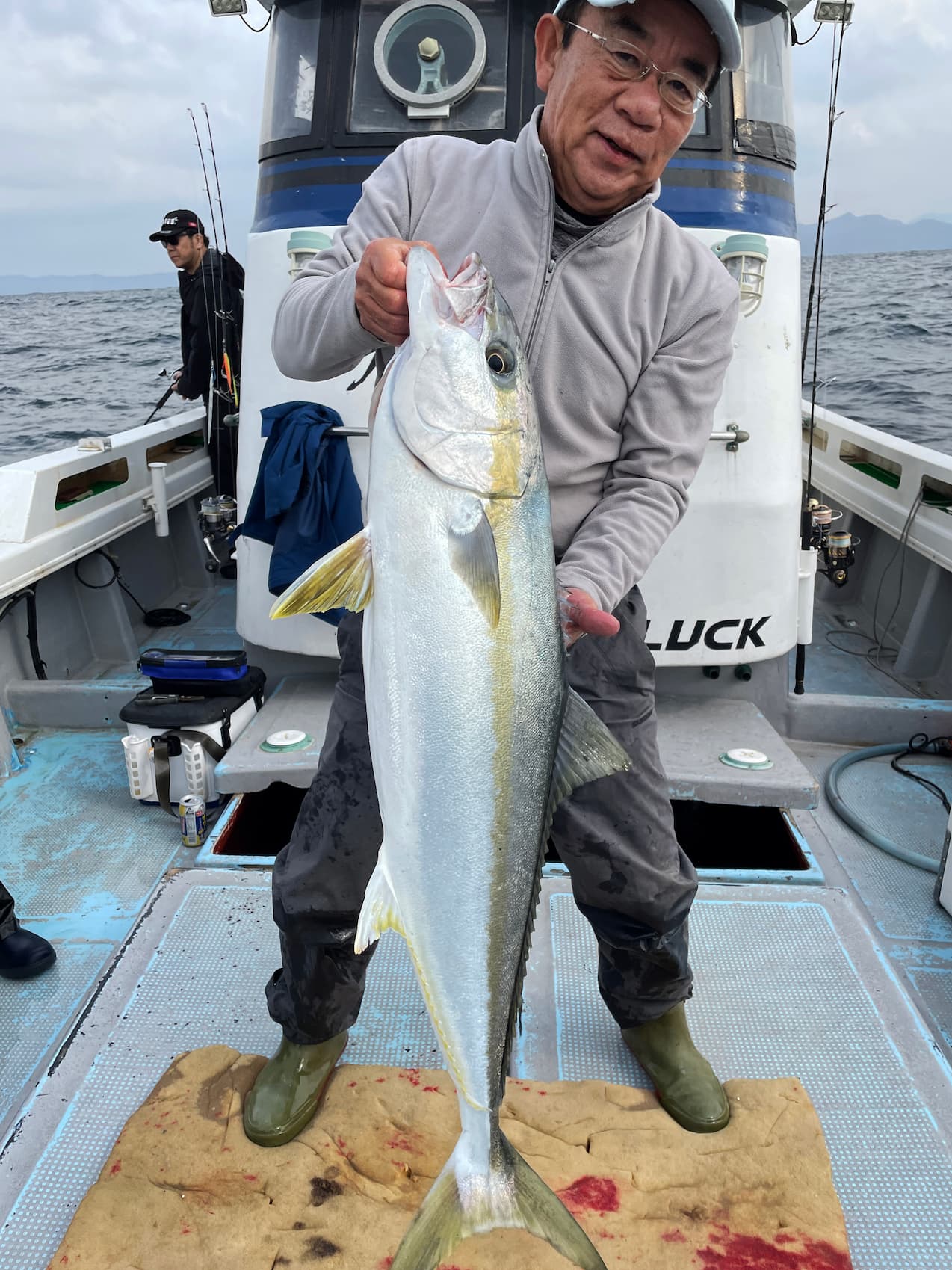
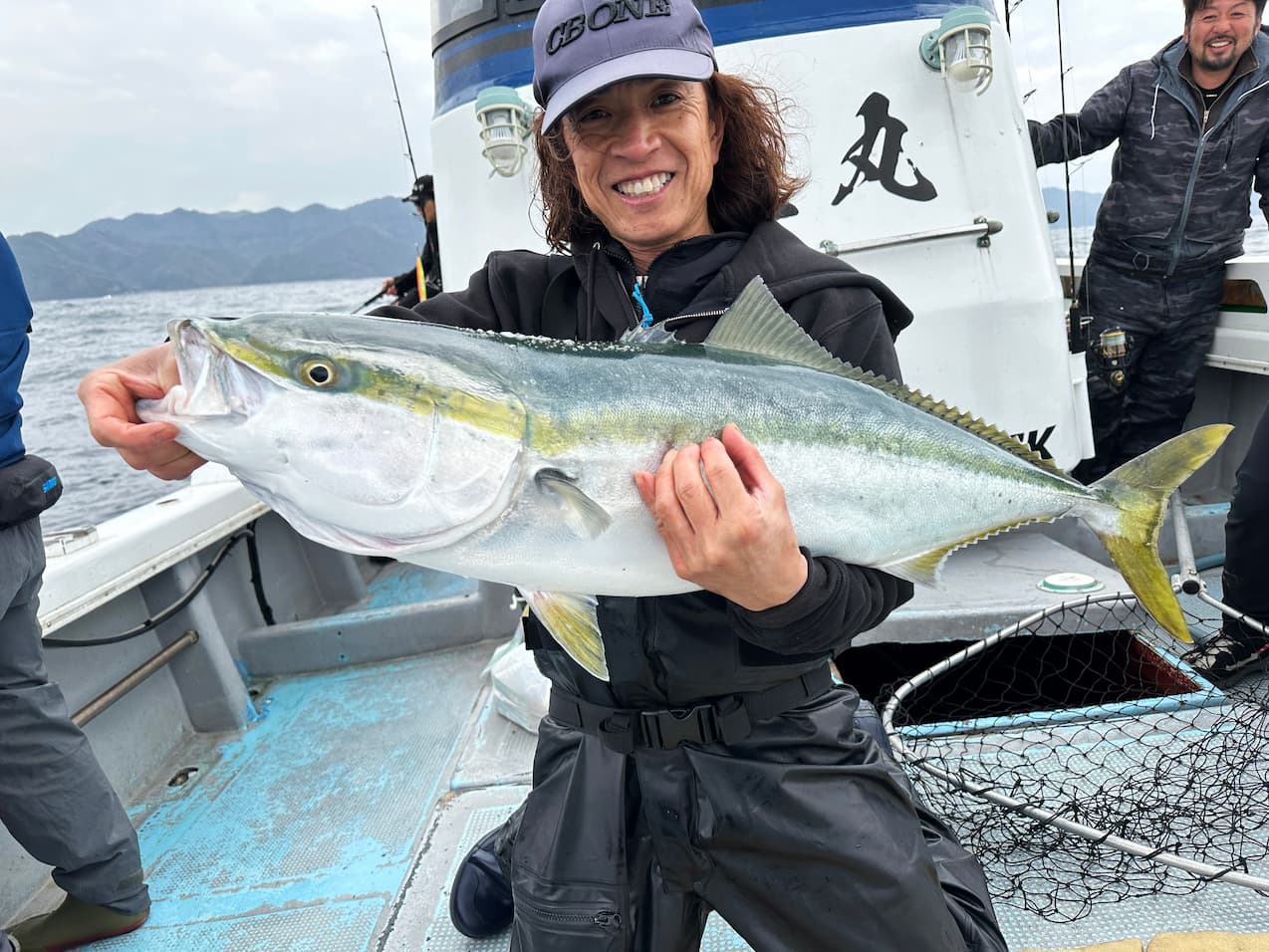
Many yellowtail up to 10 kg were also hit.
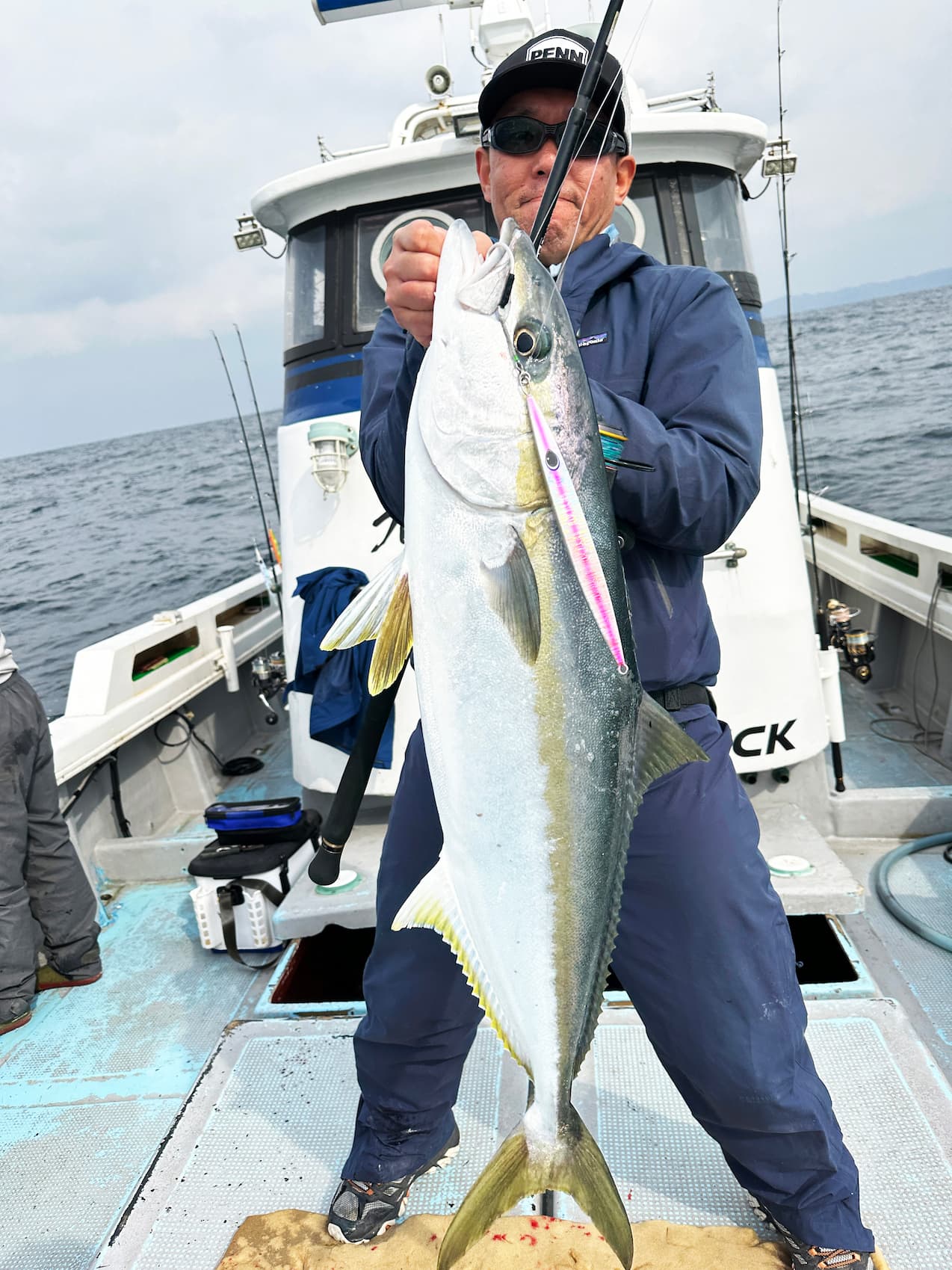
Fellow angler Tatsuya Kato. Stable hits and catches.
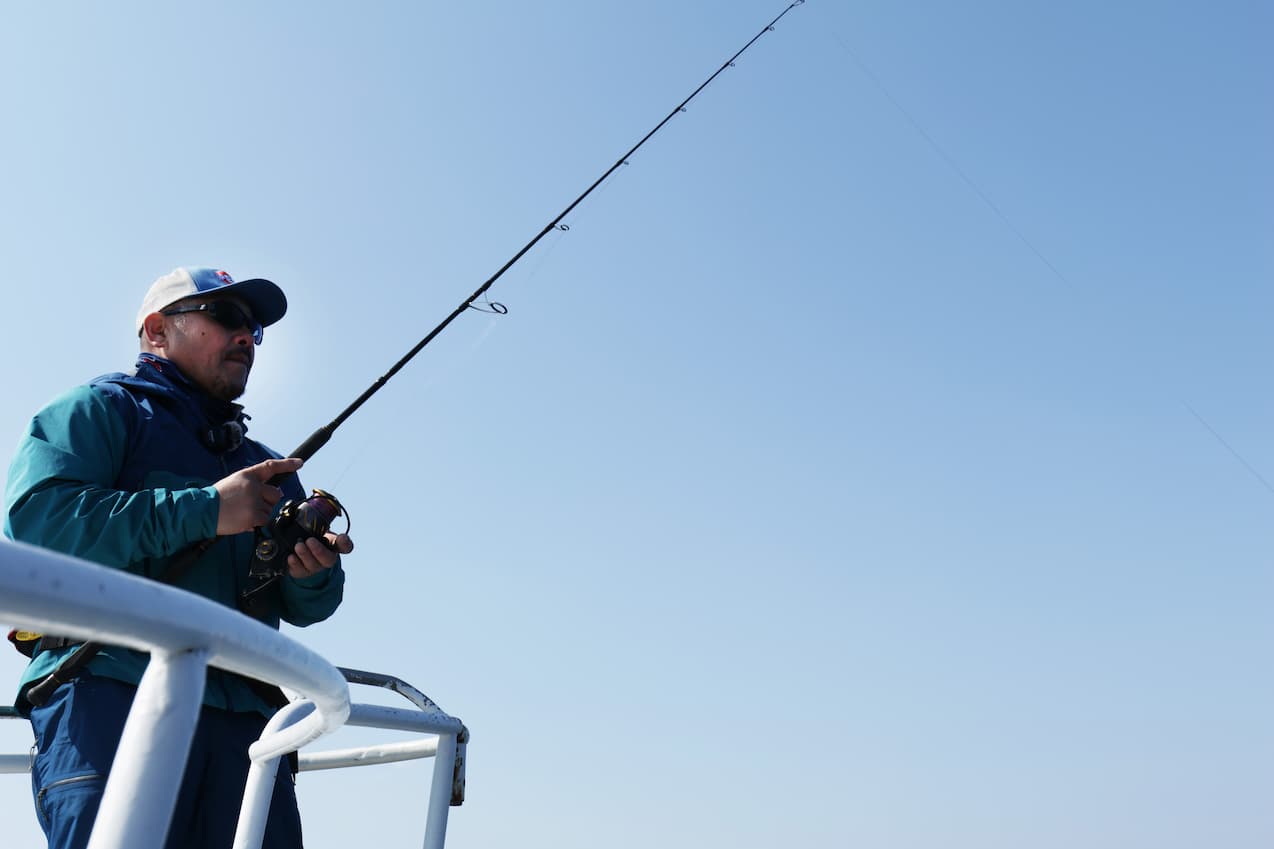
Concentrating on the fall of the jig. How is the tide moving in the water? It is important to always keep observing.
Large yellowtail use their mouths the moment the tide starts or stops moving.
I stood at the myosi position. I looked out to sea. I could see the tide was moving. I switched from a 200g KEI-JIG Scape to a Gummy 220g. Again, the bite was good, and my fellow anglers were enjoying a barrage of walleye. I first dropped the jig directly under the boat to check the boat’s current. The boat was moving and the tide was moving, and the metal jig was drifting at an angle to the bottom of the tide. So I hurriedly retrieved the metal jig and quickly reinserted the jig to cast it above the tide.
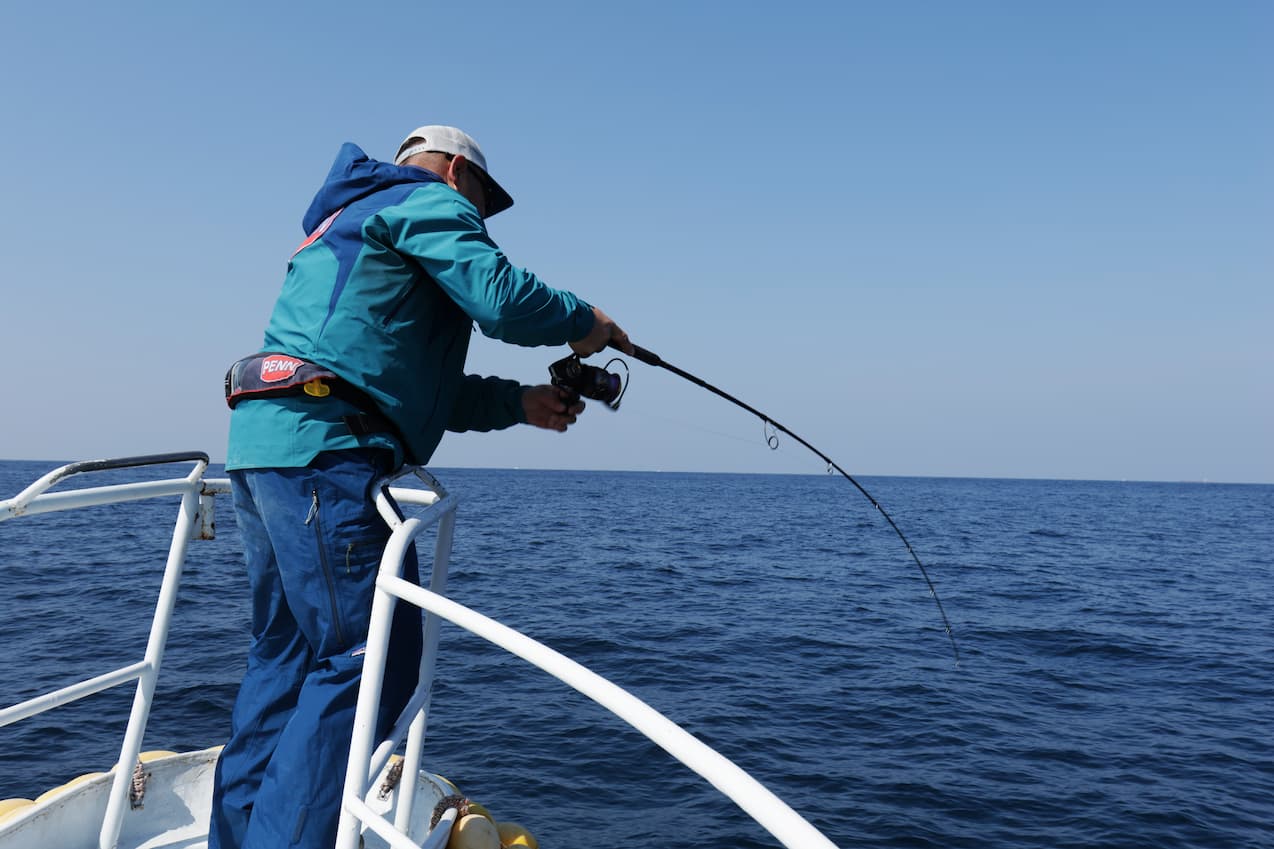
I shucked the Gummy violently from the bottom several times and let it hover. This moment is during the sunfish’s predation.
The angle between the boat and the falling line is just about in line with the bottom. Immediately start reeling in the line, including the need to recover the line slack, reel in about 10 shakes, and then drop the jig in again. After about 10 shakes, the jig was dropped in again. On the next stroke, I let the jig hover with the current and the boat’s current……this is the way I chose to aim at the moment. The jig landed on the bottom immediately, and I shook the Gummy 220g seven times with a strong first impact, and then I let the jig hover firmly. Then, it showed a violent run next to the “gutshots”.
The rod was the same as usual, Penn Slammer SLJS-63M, and the reel was Penn Authority 6500, but the drag was 7 kg stronger than usual and the leader was 80 lb, which is not like me. However, I intentionally set up this reel. I wanted to use the techniques I had learned in winter practice, and I wanted to use this to challenge the most important point of the fishing season.
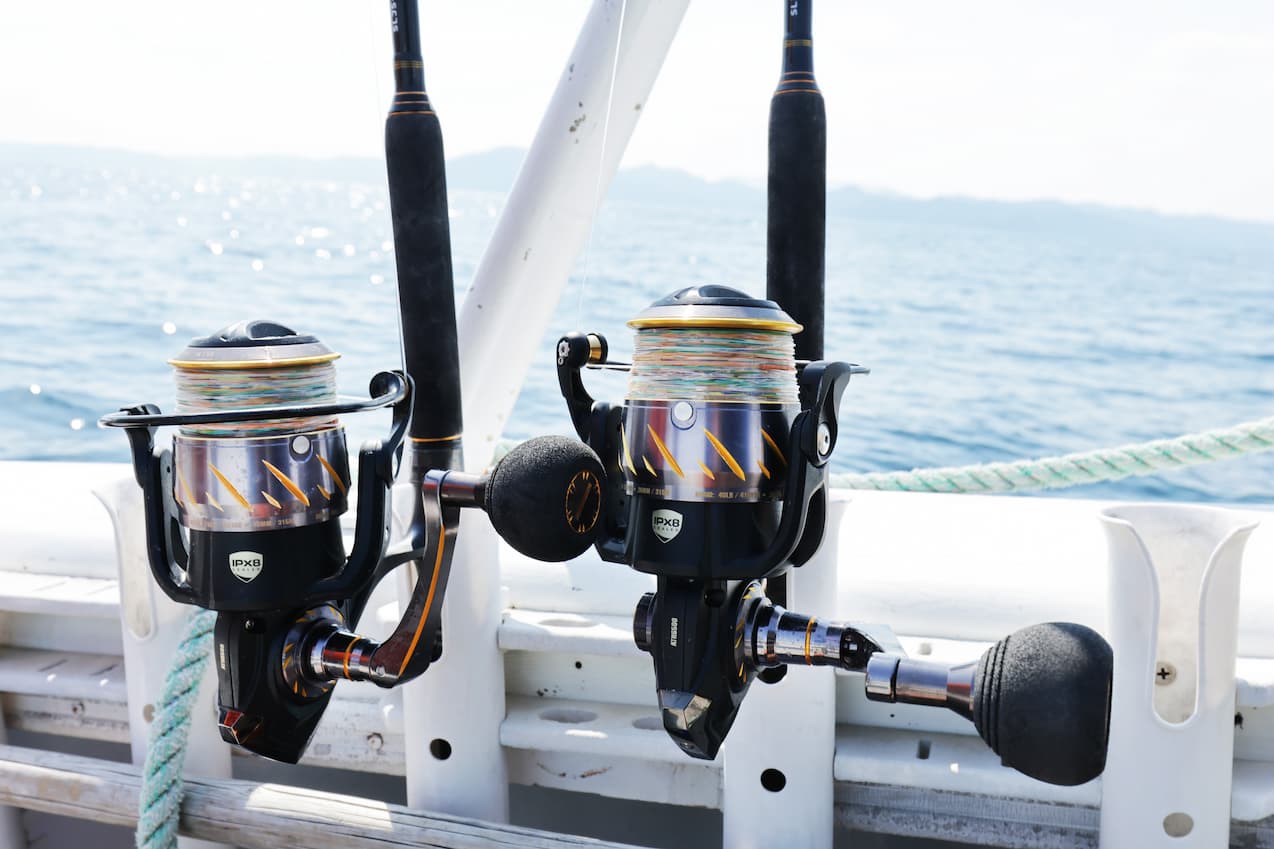
Prepare two tackles with the same rod and reel and the same line system. Different jigs on each. The reason for using the same rod, reel, and line is to make it easier to keep track of what is going on in the water, even if the jig is changed.
Rod
PENN Slammer Jigging SLJS-63M
https://www.purefishing.jp/product/penn/rod/boat-rod/penn-slammer-jigging.html
Reel
PENN Authority 6500
https://www.purefishing.jp/product/penn/sp/authority.html
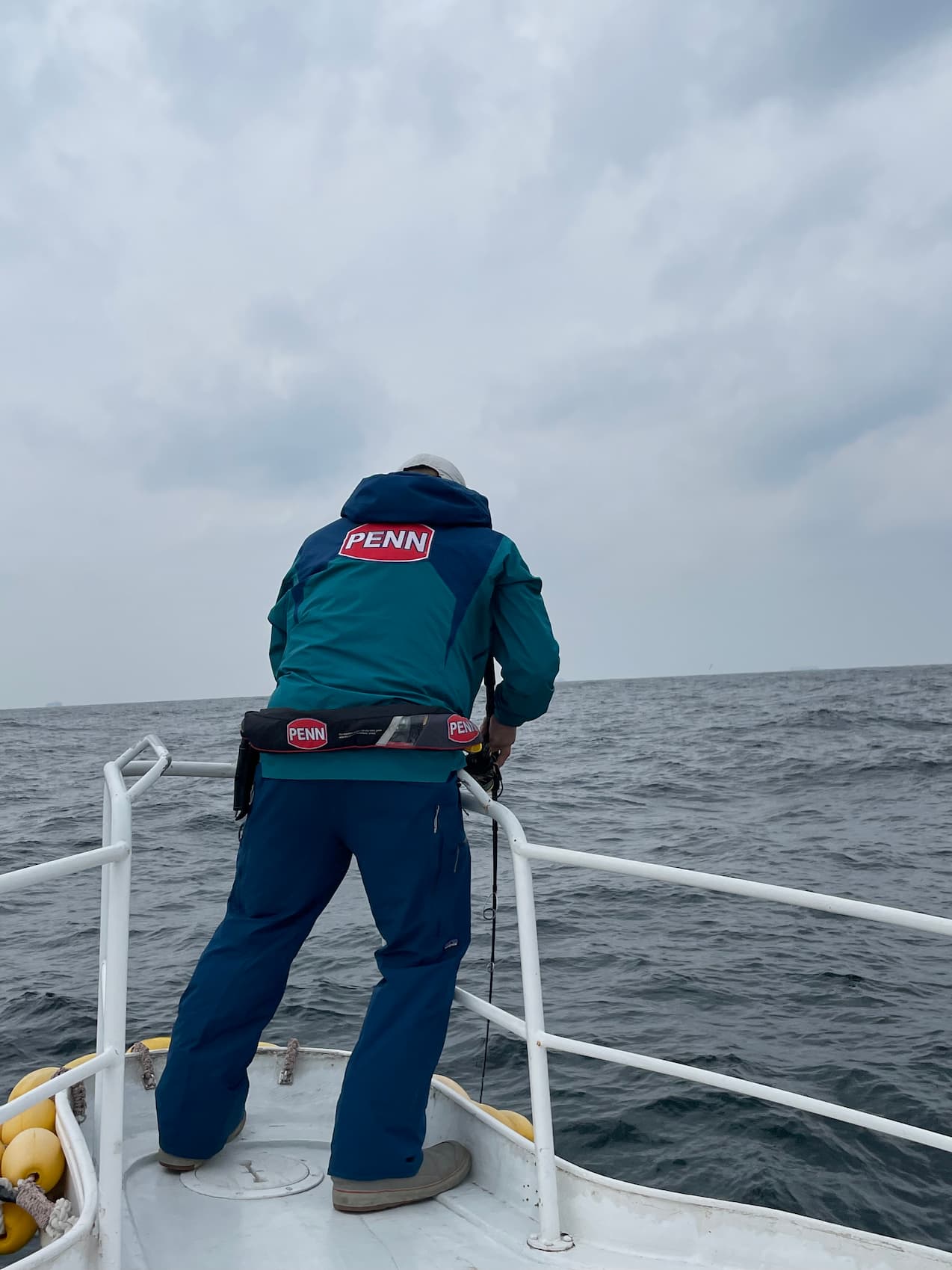
A good-sized fish hit with a thud. It showed a pull that immediately indicated it was a good size.
Captain Takuya immediately came out of the cabin and hurriedly approached the shoreline. Kei-san, it’s huge, isn’t it? The captain is always watching my movements to get the fish to bite. The way it was hitting the rod, there was no doubt that it was a good-sized yellowtail. Every year, I have experienced many yellowtail over 10 kg. But the torque of this one was clearly different. 10 kg is a wild boar, this one is a cow. The torque to pull out the line was different. The width of the head was also completely different from the 10kg size. From there, I tried to find the words to convey what I had just experienced, but I could not find them. I just concentrated on matching the fish’s movements with my whole body. I would catch the fish’s movement with my rod, reel, line, and body, and the moment the fish made an opening, I would reel it in, relying on the reel. In order to win, he does not want to give even the slightest opening. My opponent is also giving it his all. I too am not letting up, not even for a second. While engaging my opponent, I slowly began to see my chance to win. A large yellowtail appeared! .
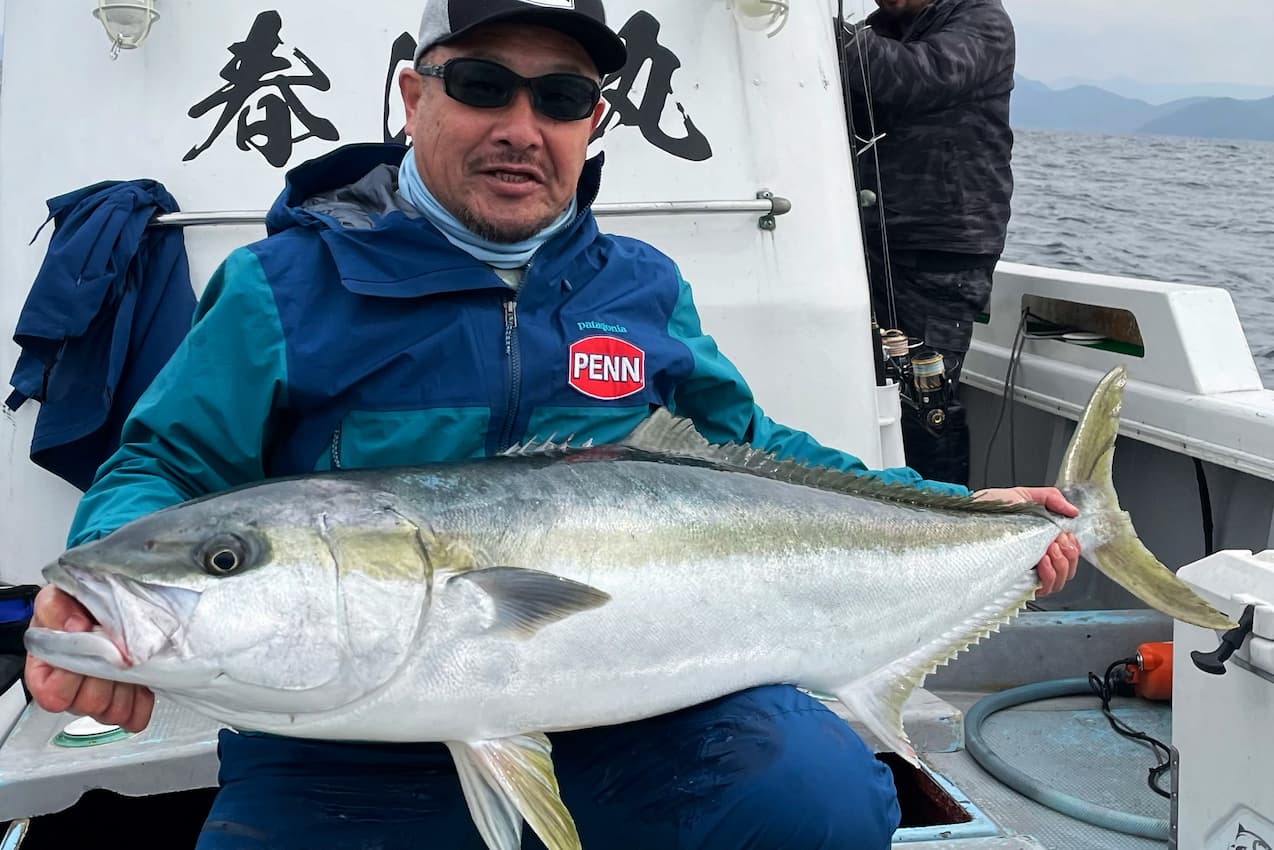
It was the third jigging yellowtail over 20 kg in my life. While casting has produced many large catches, jigging for large sunfish is quite difficult.
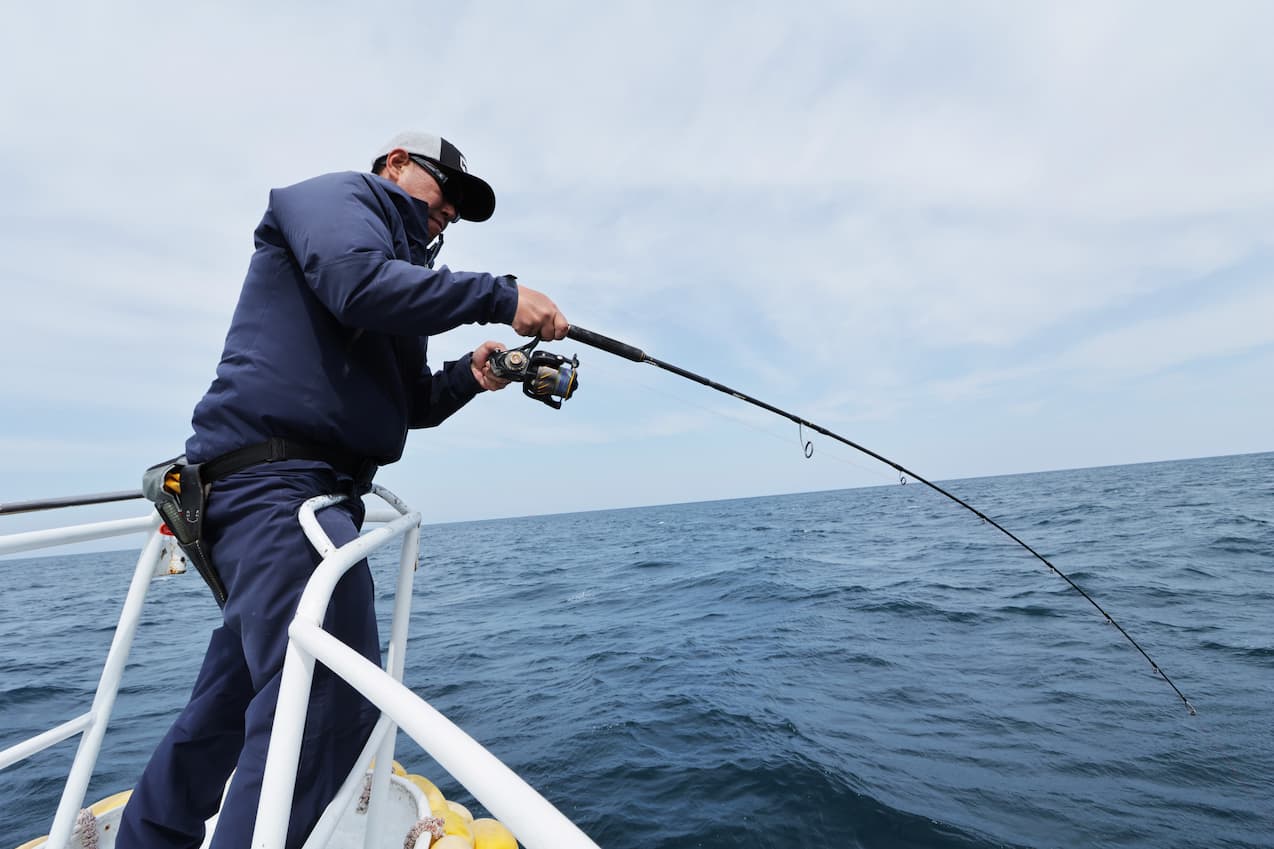
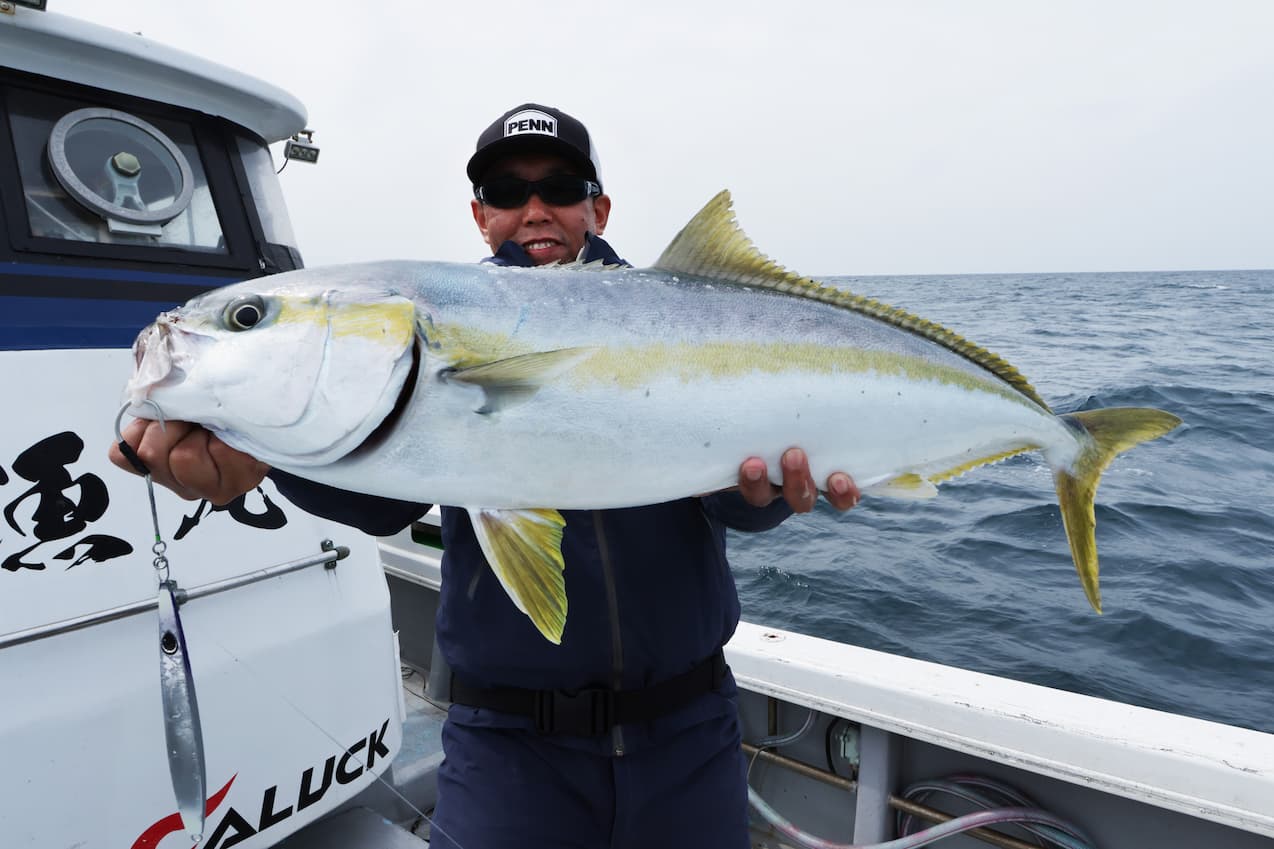
Tatsuya Kato caught a solid yellowtail during the manufacturer’s photo shoot in the latter half of the fishing trip.
Hiramatsu-style must-have patterns.
When the tide is running, the fish are more active. When the tide stops, the fish stop biting even if they are responding. This is what everyone understands in fishing, and simply put, it is understood as “Toki Go” (time of the season). The timing when you can catch a lot of fish is the time of the season. The timing when the fish you are targeting use their mouths is also a “time”. Each angler has his or her own “time of the season,” and my time of the season is when the big fish are ready to bite. The current changes with the ebb and flow of the tide, and the bigger the tide, the more clearly the difference is. On this trip to Tsushima, I was able to target and feed only good-sized yellowtail. This was exactly the same method we used to catch the 20.17kg sunfish we caught on the first day, followed by the 15.2kg and 15.5kg sunfish we caught later in the day.
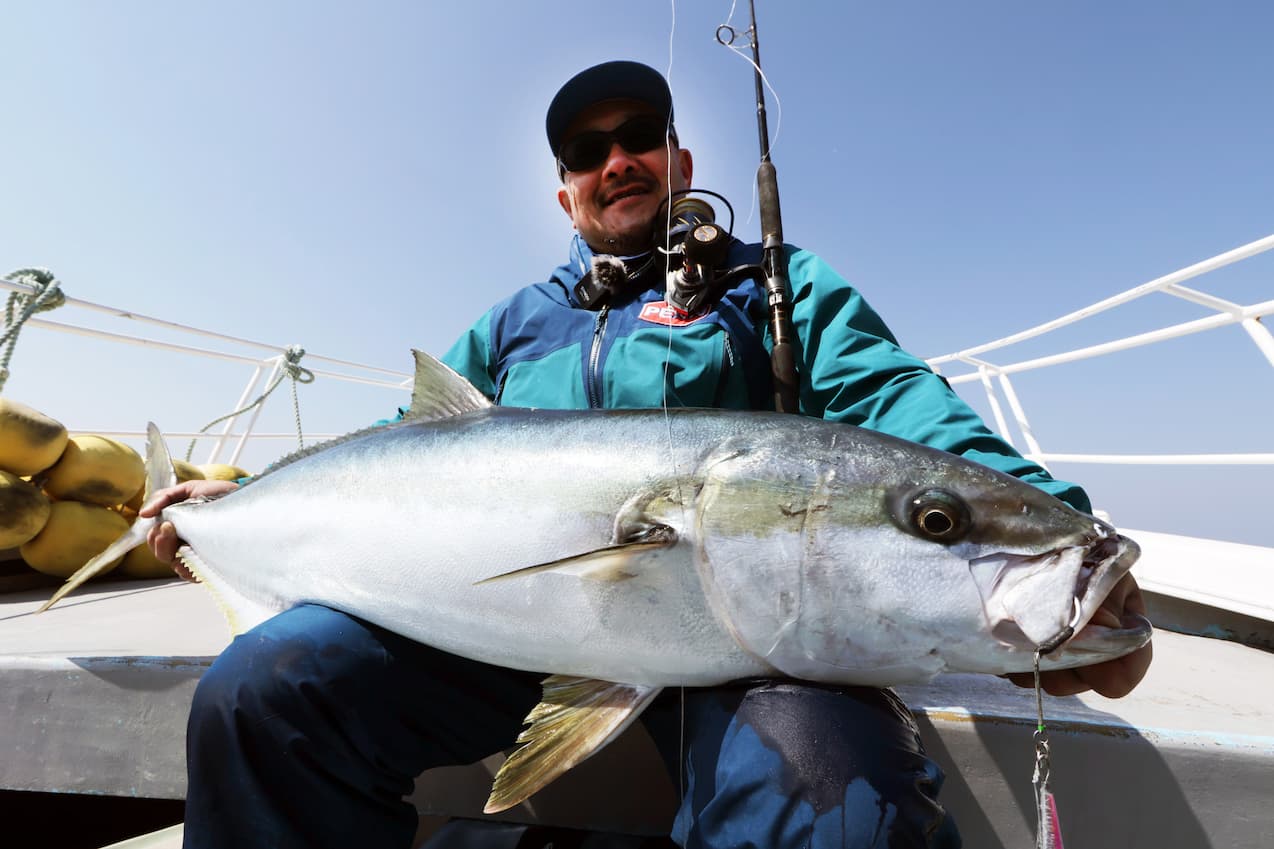
A 15.2 kg yellowtail caught on the fourth day of fishing. This fish was also caught by hovering the Gummy when the tide changed, just as the first one did.
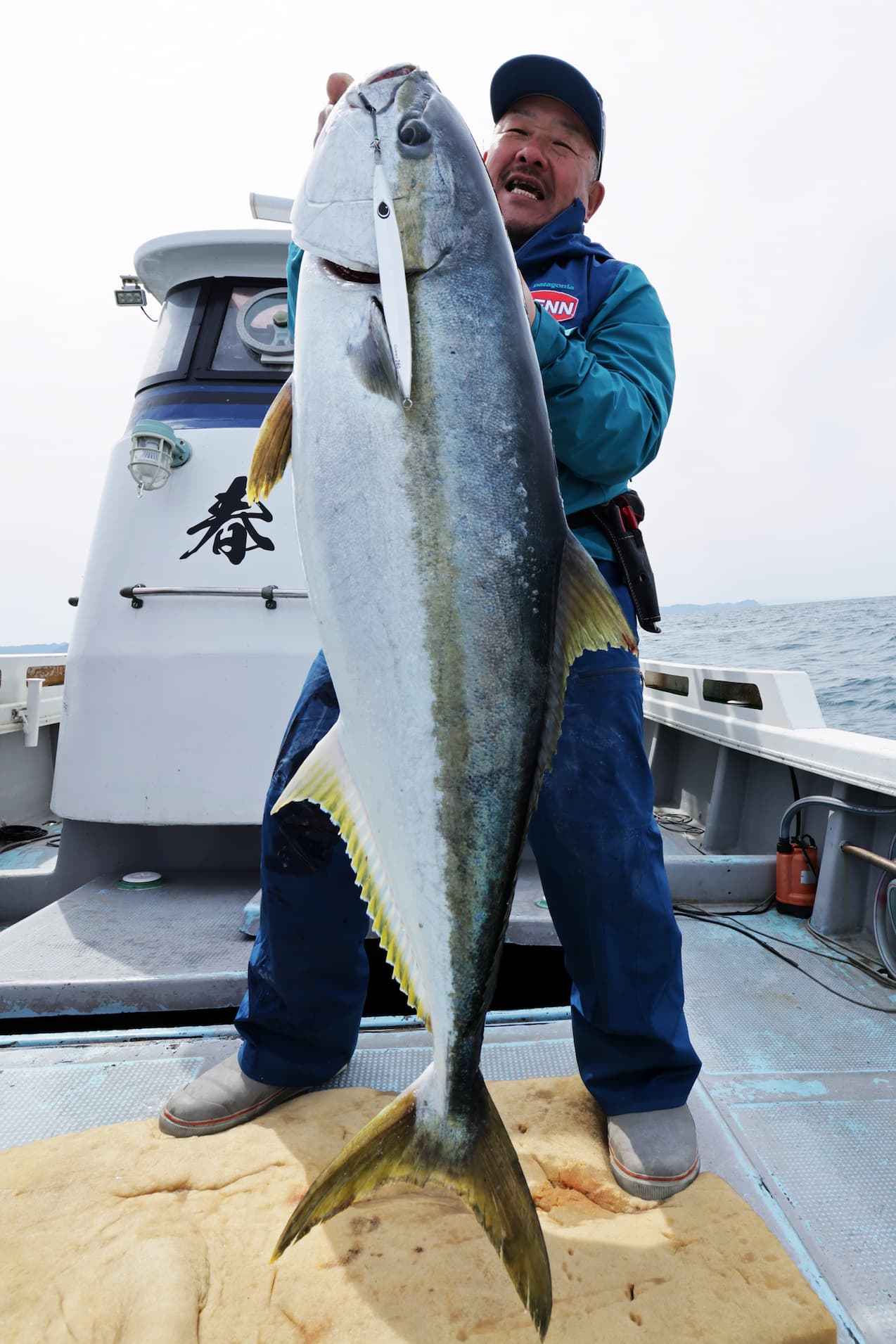
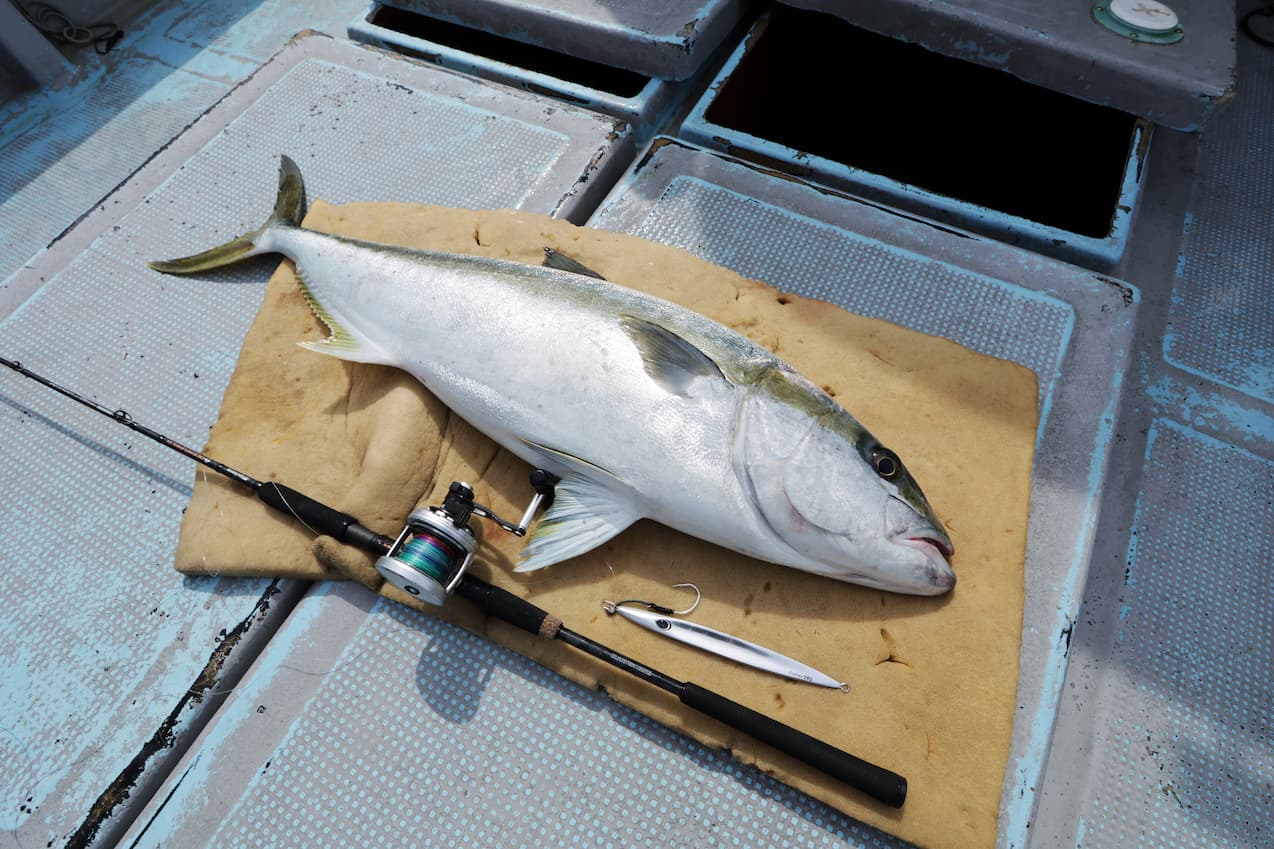
The third good-sized Hiramasa weighing 15.5 kg, not long, but a big fish. When the tide started to run, I hooked it by hovering the heavy Gummy on a bait reel.
The 20.17-kg yellowtail I caught on the first day was the third 20-kg-plus yellowtail I had caught while jigging. The three over 20 kg catches so far had been caught “before the tide stopped” and “at the beginning of the tide. The 20.5-kg yellowtail caught on Jeju Island, Korea, just before the tide stopped. The 20.5-kg fish at Mikurashima, Izu Islands, was caught just before the tide started to move. On Mikurashima, I caught a yellowtail over 20 kg, and after that all we had were yellowfin tuna. It was because the tide started to flow steadily. And anglers around us were enjoying the hits by fishing with the yellowfin tuna that were being caught. It is important not only to match the fish you are catching, but also to target the fish according to the species you want to catch, if you have a specific fish in mind. Because I wanted to catch yellowtail and amberjack by jigging, I thoroughly targeted the yellowtail and amberjack layers without being distracted by mid-water reactions, and as a result, I caught fish.
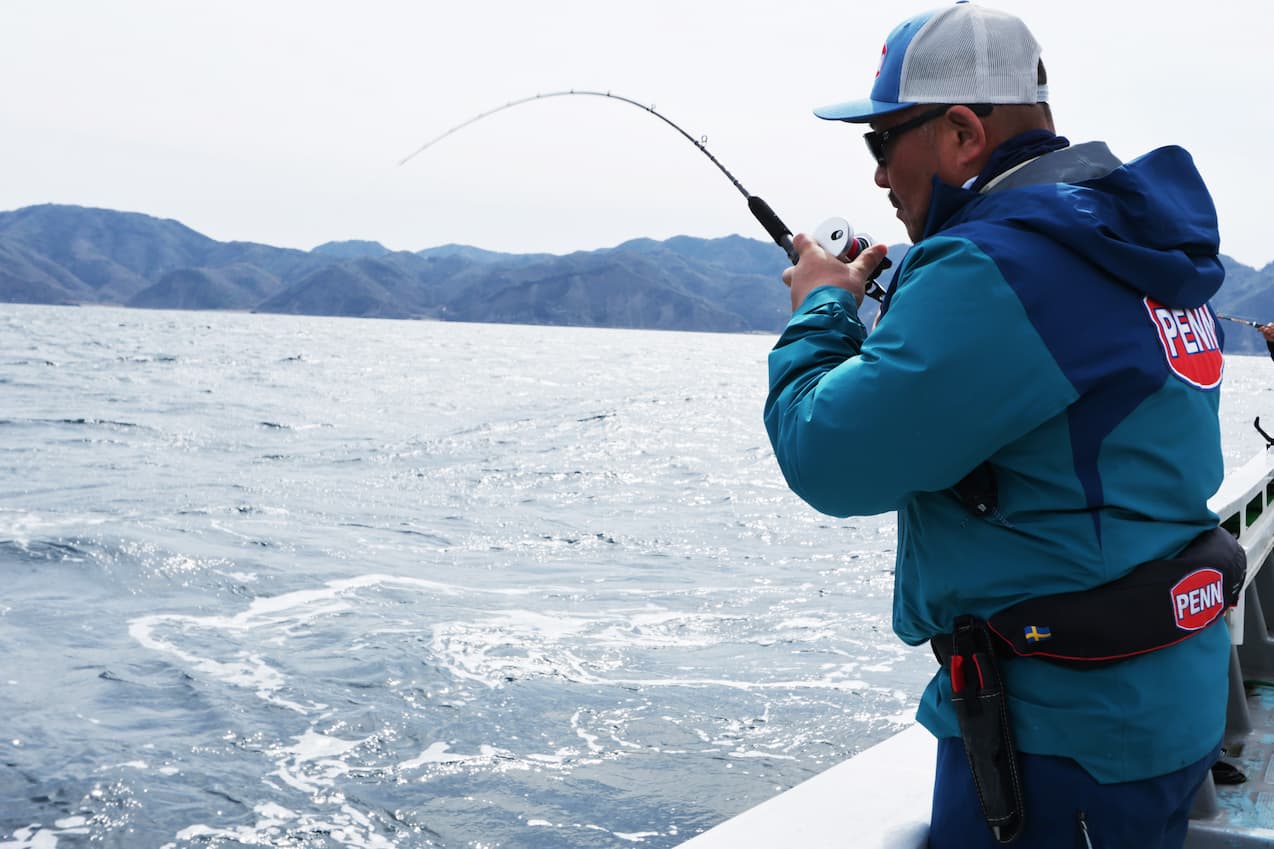
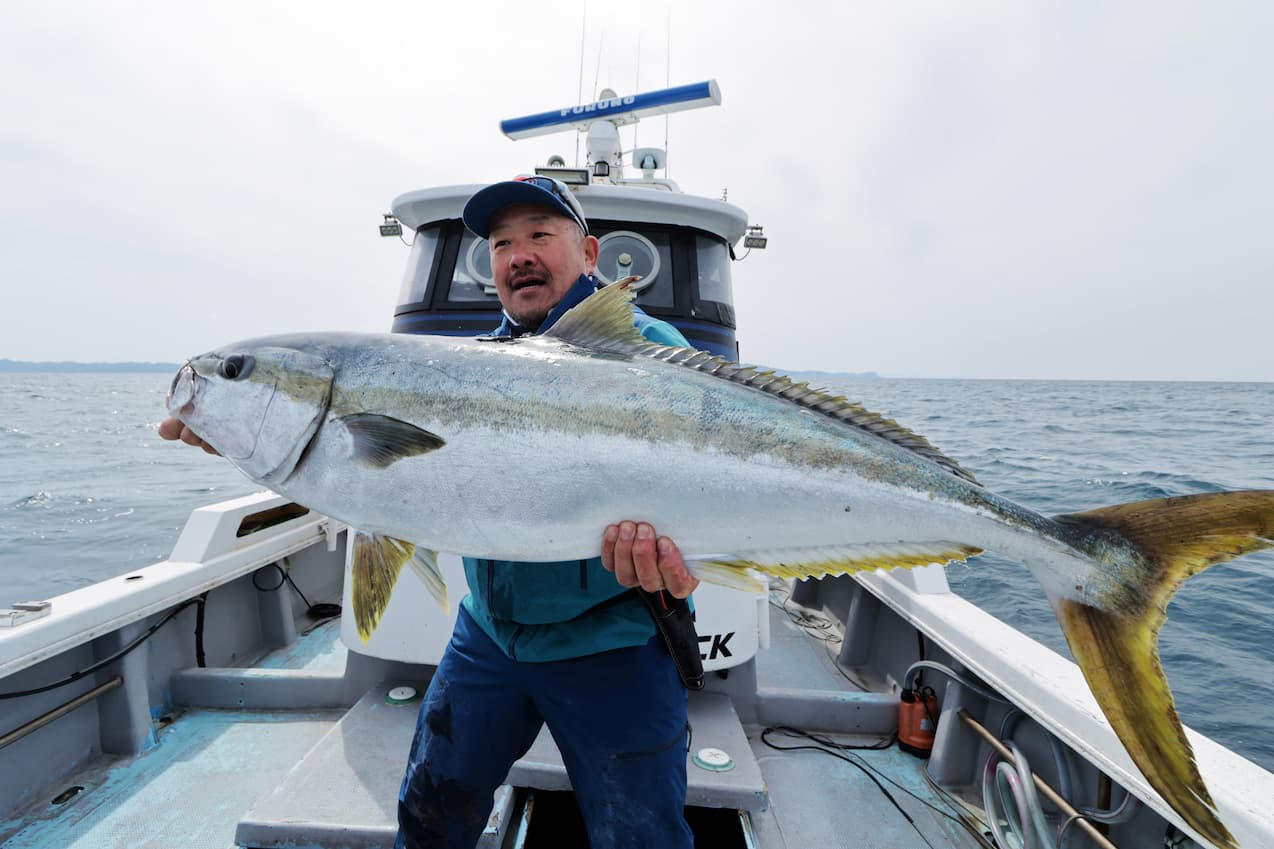
I always sense when the tide starts to move from the jig and the line. That’s why I always use the same spinning tackle as my main tackle, changing only the jig weight. When I caught a 15.5kg yellowtail on the last day of the fishing season, I got the hit by using bait tackle in between the body of the fish. He had been fishing with spinning tackle until then, but he felt the tide was strong and decided to use a heavier jig weight and a 45-lb leader instead of an 80-lb leader, and his strategy of fishing between the body of the fish was successful. There is only a split second when a large fish bites. It is important to know what kind of attack to make at that moment. This time, I believe that my continued practice and learning at my “Hiramasa Dojo” led to the successful result.
Off the coast of Tsushima, Nagasaki Prefecture, where he has been going for 29 years. In the winter and spring, the probability of catching big ones increases and anglers are excited. What I have seen over the past 28 years is that the migration season of bigeye yellowtail off Tsushima has become earlier, and the timing of the drift of seawater contamination (dead plankton, decaying seaweed, etc.) has changed. From these factors, we are gradually updating our own thinking to respond to these changes and aim for them. It doesn’t matter which area, but I strongly feel that I can only achieve the kind of fishing results I have this time by continuing to fish there and being able to sense the changes in the field. Although my physical condition becomes more difficult every year, I have more “drawers” and my senses are getting better. I also feel that I have more confidence in my fishing. That is why I would like to continue my training in the “yellowtail Dojo.
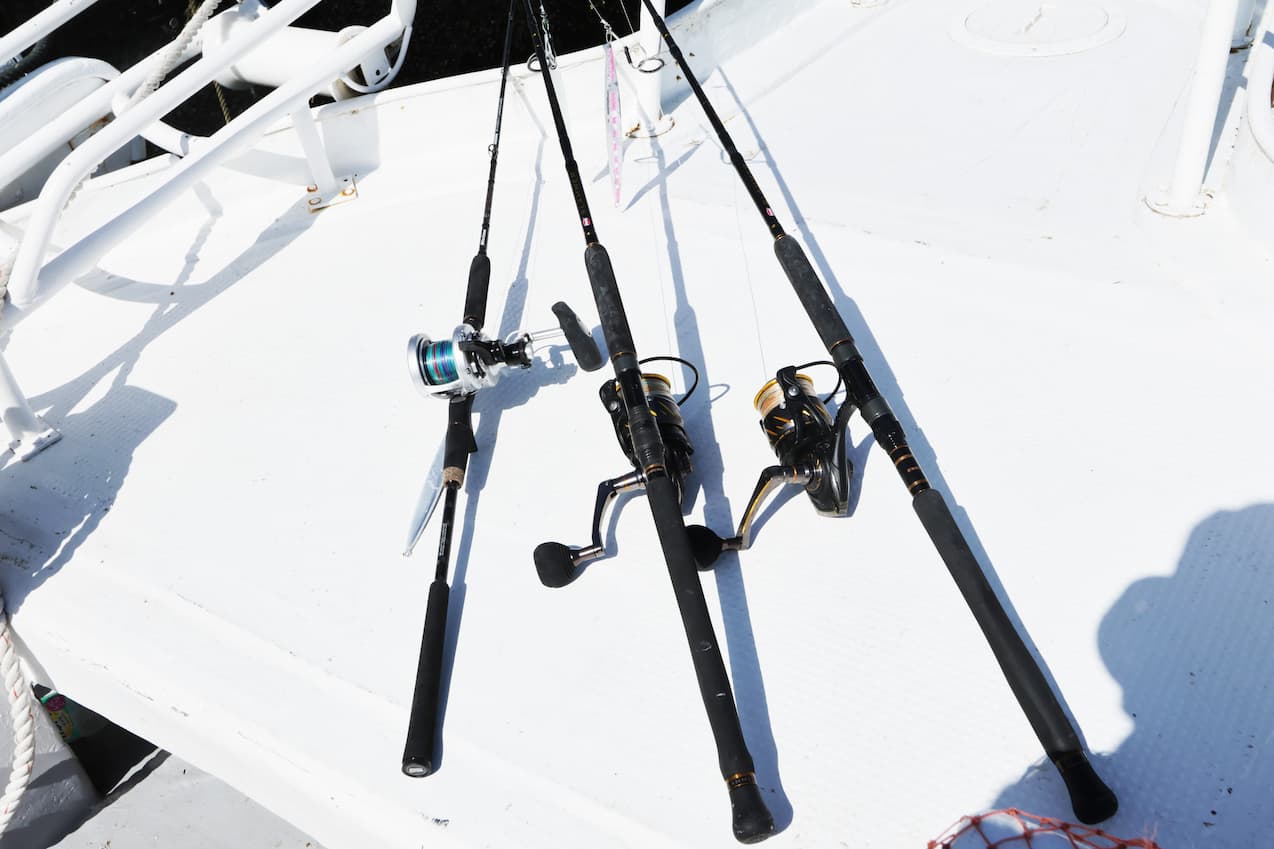
Spinning jigging tackle
Rod: PENN SLJS-63M
Reel: PENN Authority 6500
Line & Leader: Sunline Amazer X8 #4 + Tunagito 80 lb.
Lure: K-FLAT
Gummy 200g-310g, Gummy-fat 250g, KEI Jig 235g KEI Jig, Sharp 260g
Hooks and parts: Owner JS-39 Blue Chaser 13/0, 11/0 + Hyper Wire #7 & Solid Ring 6.5mm
Bait jigging tackle
Rod: AbuGarcia Ocean Field 62M
Reel: PENN Fathom 2 25NL2 speed
Line & Leader: Sunline Amazer X8 No. 4 + Tunagito 45lb
Lure: K-FLAT
Gummy 200g-310g, Gummy-fat 250g, KEI Jig 235g, KEI Jig sharp 260g
Hooks & Parts: Owner JS-39 Blue Chaser 11/0 + Hyper Wire #7 & Solid Ring 6.5mm
Polarized Lens: Glenfield ZEQUE “STELTH
Wear:Patagonia
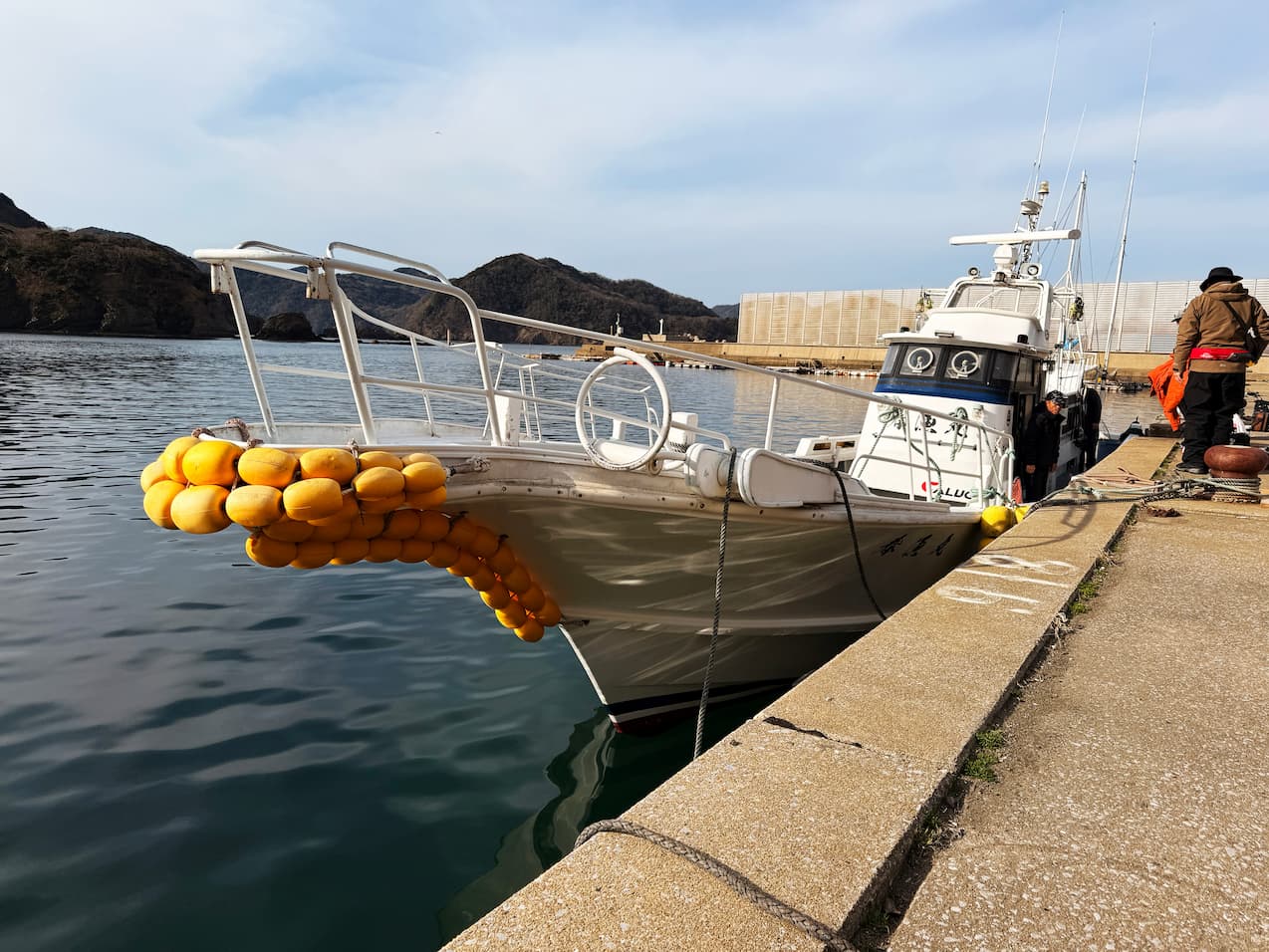
Haru Fishery Maru
Captain Naomi Haruta, Young Captain Takuya
http://shunryomaru.com/
Tackle inquiries
Goldic (closed on Tuesdays)
https://www.goldic.net/
Kei Hiramatsu’s official blog Iibusa Diary
https://kei-hiramatsu.com/
Kei Hiramatsu facebook
https://www.facebook.com/hiramatsu.kei.1
X(Twitter)
@keitanhiramatsu
YouTube
Kei Hiramatsu channel


